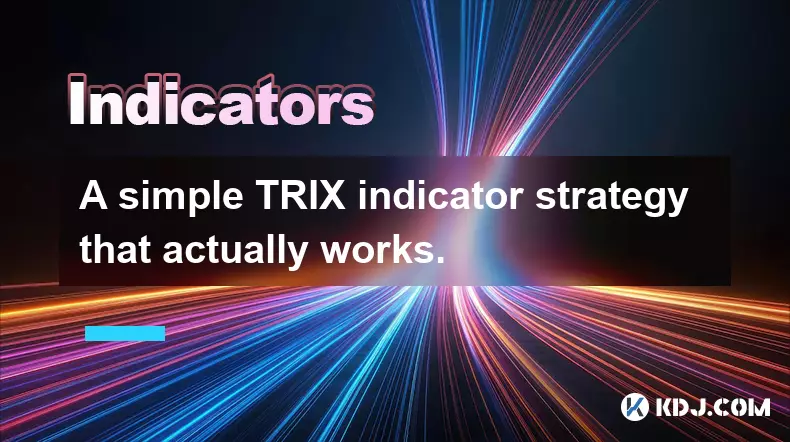-
 bitcoin
bitcoin $102877.190955 USD
1.88% -
 ethereum
ethereum $3430.435064 USD
4.52% -
 tether
tether $0.999264 USD
-0.05% -
 xrp
xrp $2.307310 USD
4.49% -
 bnb
bnb $987.740692 USD
3.82% -
 solana
solana $161.947760 USD
3.97% -
 usd-coin
usd-coin $0.999712 USD
-0.05% -
 tron
tron $0.292810 USD
2.93% -
 dogecoin
dogecoin $0.179738 USD
10.70% -
 cardano
cardano $0.580716 USD
8.75% -
 hyperliquid
hyperliquid $42.463448 USD
8.40% -
 chainlink
chainlink $15.763437 USD
7.05% -
 zcash
zcash $649.595636 USD
17.21% -
 bitcoin-cash
bitcoin-cash $511.610261 USD
7.19% -
 stellar
stellar $0.292537 USD
7.91%
How to interpret the K, D, and J lines on the KDJ indicator?
The KDJ indicator uses K, D, and J lines to spot overbought/oversold levels and momentum shifts, helping traders time entries in volatile crypto markets.
Nov 07, 2025 at 01:00 am

KDJ Indicator: Understanding the K, D, and J Lines
The KDJ indicator is a momentum oscillator widely used in cryptocurrency trading to identify overbought or oversold conditions. It expands on the Stochastic Oscillator by introducing a third line—J—which provides additional insight into price momentum. Traders rely on the interplay between the K, D, and J lines to time entries and exits in volatile markets.
Interpretation of the K Line
- The K line, also known as the fast %K, reflects the current closing price relative to the high-low range over a specified period, typically 9 candles.
- It reacts quickly to price changes, making it sensitive to short-term market movements in assets like Bitcoin or Ethereum.
- When the K line rises above 80, the asset may be overbought, signaling a potential reversal or pullback.
- If the K line drops below 20, it suggests the market could be oversold, indicating a possible upward correction.
- Crossovers between the K and D lines are often used as trade signals, with bullish signs emerging when K crosses above D from below.
Role and Significance of the D Line
- The D line is a smoothed version of the K line, usually calculated as a 3-period moving average of K.
- It acts as a signal line, helping traders confirm trends and filter out noise caused by sudden price spikes.
- A rising D line in the lower zone (below 20) can indicate strengthening bullish momentum after a downtrend.
- Conversely, a declining D line above 80 may suggest bearish pressure building after an extended rally.
- Divergence between price action and the D line can reveal weakening momentum, especially in altcoins with low liquidity.
Functionality of the J Line
- The J line is derived from the formula: J = 3 × K – 2 × D, which amplifies the volatility of the K and D lines.
- Because of its sensitivity, the J line often moves outside the standard 0–100 range, providing early warnings of extreme market conditions.
- When the J line surges above 100, it indicates excessive buying pressure that may not be sustainable.
- A plunge below 0 suggests panic selling, commonly seen during flash crashes in leveraged crypto markets.
- Traders watch for J line reversals from extreme levels as potential entry points, particularly in range-bound cryptocurrencies.
Common Trading Signals Generated by KDJ
- Bullish crossovers occur when the K line crosses above the D line in the oversold region, suggesting accumulation.
- Bearish crossovers happen when K crosses below D in the overbought zone, often preceding profit-taking phases.
- Hidden bullish divergence forms when price makes a lower low but KDJ forms a higher low, hinting at strength beneath the surface.
- Extreme J values followed by sharp turns can act as contrarian signals, especially useful in highly speculative memecoins.
- Simultaneous alignment of all three lines in the lower zone may indicate a strong reversal setup after prolonged declines.
Frequently Asked Questions
What does it mean when the J line exceeds 100?A J line above 100 suggests the market is stretched in the upward direction, often due to aggressive buying or FOMO-driven rallies. This condition is unsustainable and may precede a correction, particularly in assets with thin order books.
Can the KDJ indicator be applied to different timeframes?Yes, the KDJ works across various timeframes—from 5-minute charts for scalping to daily charts for swing trading. Shorter intervals increase sensitivity, while longer periods provide more reliable signals in trending markets.
How should traders handle false signals from KDJ in sideways markets?In choppy or consolidating conditions, KDJ may generate frequent crossovers that lead to whipsaws. Combining it with volume analysis or trend-following indicators like EMA can improve accuracy and reduce false triggers.
Is the KDJ suitable for all types of cryptocurrencies?While applicable to most digital assets, KDJ performs best in instruments with consistent volatility and sufficient trading volume. Low-cap tokens with erratic price action may produce misleading readings due to manipulation or low liquidity.
Disclaimer:info@kdj.com
The information provided is not trading advice. kdj.com does not assume any responsibility for any investments made based on the information provided in this article. Cryptocurrencies are highly volatile and it is highly recommended that you invest with caution after thorough research!
If you believe that the content used on this website infringes your copyright, please contact us immediately (info@kdj.com) and we will delete it promptly.
- Ripple (XRP) in 2026: Hold or Fold? A Look at XRP's Future and Emerging DeFi Alternatives
- 2025-11-08 18:35:01
- Zcash ZEC Coin Price Explosion: From Privacy Niche to Center Stage
- 2025-11-08 18:55:01
- Berachain Price Prediction: Navigating the Honeycomb Hype in Crypto
- 2025-11-08 18:55:01
- Arthur Hayes, Gold, and Bitcoin: A Modern Monetary Trinity?
- 2025-11-08 19:15:01
- Shiba Inu's Next Move: Navigating a Shifting Market
- 2025-11-08 19:20:01
- Pakistan's Crypto Crossroads: Balancing Opportunity with Asset-Backed Realities
- 2025-11-08 19:20:01
Related knowledge

How do professional traders use the TRIX indicator?
Nov 06,2025 at 04:40pm
Understanding the TRIX Indicator in Crypto TradingThe TRIX (Triple Exponential Average) indicator is a momentum oscillator used by professional trader...

Can I use the TRIX indicator on my mobile trading app?
Nov 07,2025 at 07:40pm
The TRIX indicator, a momentum oscillator designed to filter out short-term fluctuations and highlight long-term trends, has become increasingly popul...

How to code a simple TRIX indicator script in Pine Script?
Nov 07,2025 at 06:20am
How to Code a Simple TRIX Indicator in Pine Script The TRIX (Triple Exponential Moving Average) indicator is widely used in cryptocurrency trading to ...

A simple TRIX indicator strategy that actually works.
Nov 08,2025 at 05:39pm
Understanding the TRIX Indicator in Crypto Trading1. The TRIX (Triple Exponential Average) indicator is a momentum oscillator designed to filter out s...

How to trade TRIX indicator signals on the 1-hour chart?
Nov 07,2025 at 05:39am
Bitcoin's Role in Decentralized Finance1. Bitcoin remains the cornerstone of decentralized finance, serving as a benchmark for value and security acro...

Can the TRIX indicator be used for long-term investing?
Nov 06,2025 at 02:19pm
Understanding the TRIX Indicator in Cryptocurrency Markets1. The TRIX (Triple Exponential Average) indicator is a momentum oscillator designed to filt...

How do professional traders use the TRIX indicator?
Nov 06,2025 at 04:40pm
Understanding the TRIX Indicator in Crypto TradingThe TRIX (Triple Exponential Average) indicator is a momentum oscillator used by professional trader...

Can I use the TRIX indicator on my mobile trading app?
Nov 07,2025 at 07:40pm
The TRIX indicator, a momentum oscillator designed to filter out short-term fluctuations and highlight long-term trends, has become increasingly popul...

How to code a simple TRIX indicator script in Pine Script?
Nov 07,2025 at 06:20am
How to Code a Simple TRIX Indicator in Pine Script The TRIX (Triple Exponential Moving Average) indicator is widely used in cryptocurrency trading to ...

A simple TRIX indicator strategy that actually works.
Nov 08,2025 at 05:39pm
Understanding the TRIX Indicator in Crypto Trading1. The TRIX (Triple Exponential Average) indicator is a momentum oscillator designed to filter out s...

How to trade TRIX indicator signals on the 1-hour chart?
Nov 07,2025 at 05:39am
Bitcoin's Role in Decentralized Finance1. Bitcoin remains the cornerstone of decentralized finance, serving as a benchmark for value and security acro...

Can the TRIX indicator be used for long-term investing?
Nov 06,2025 at 02:19pm
Understanding the TRIX Indicator in Cryptocurrency Markets1. The TRIX (Triple Exponential Average) indicator is a momentum oscillator designed to filt...
See all articles





















![The Graph Price Prediction [GRT Crypto Price News Today] The Graph Price Prediction [GRT Crypto Price News Today]](/uploads/2025/11/07/cryptocurrencies-news/videos/690d4df44fe69_image_500_375.webp)



















































